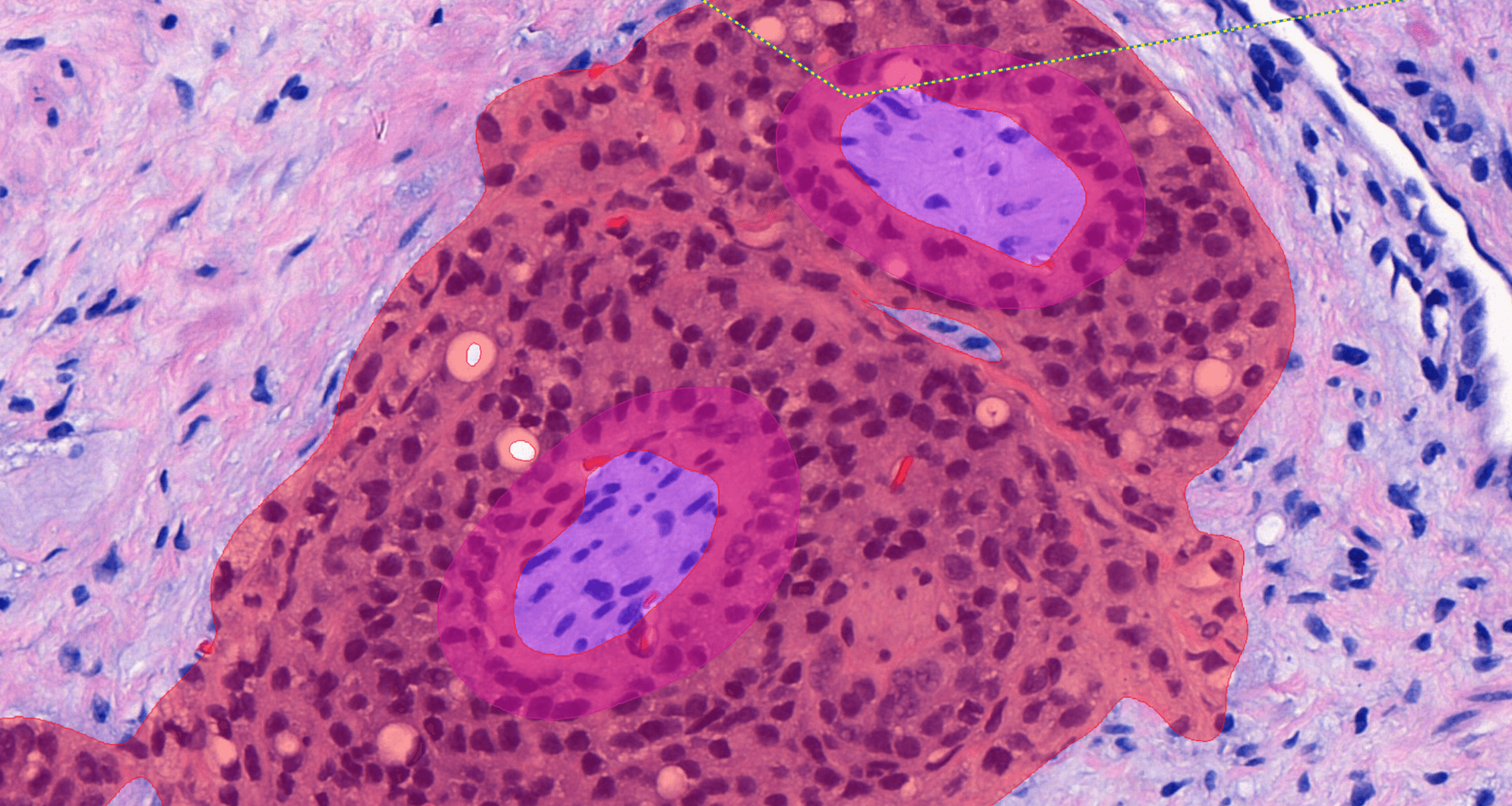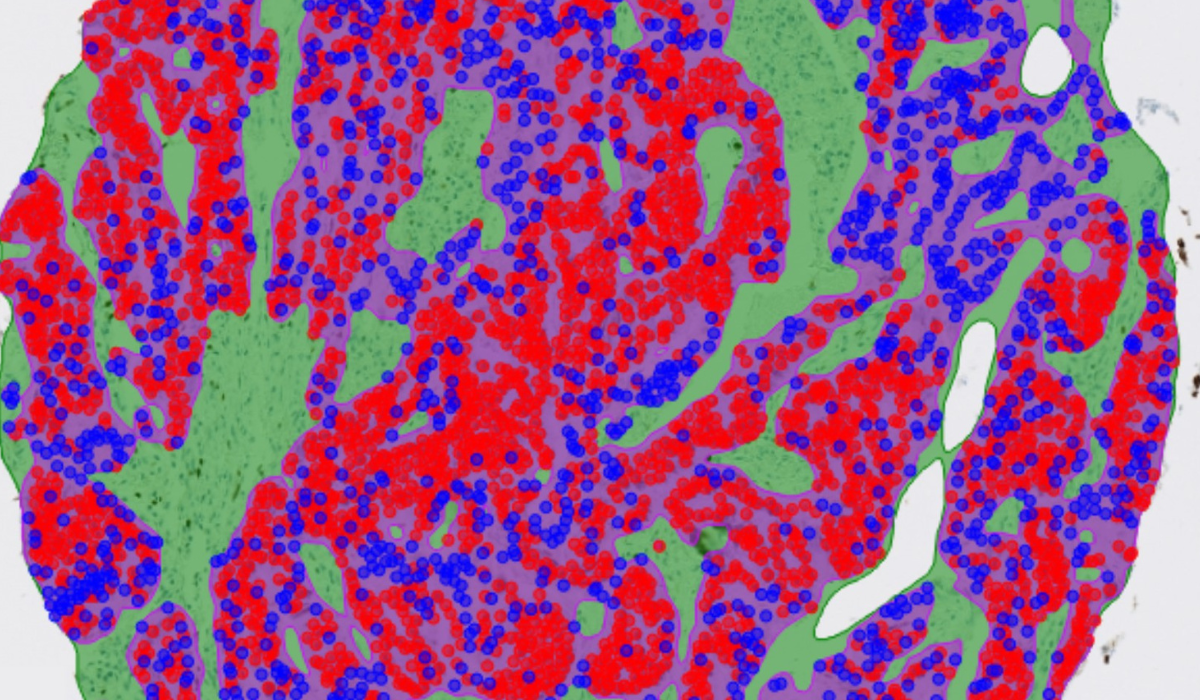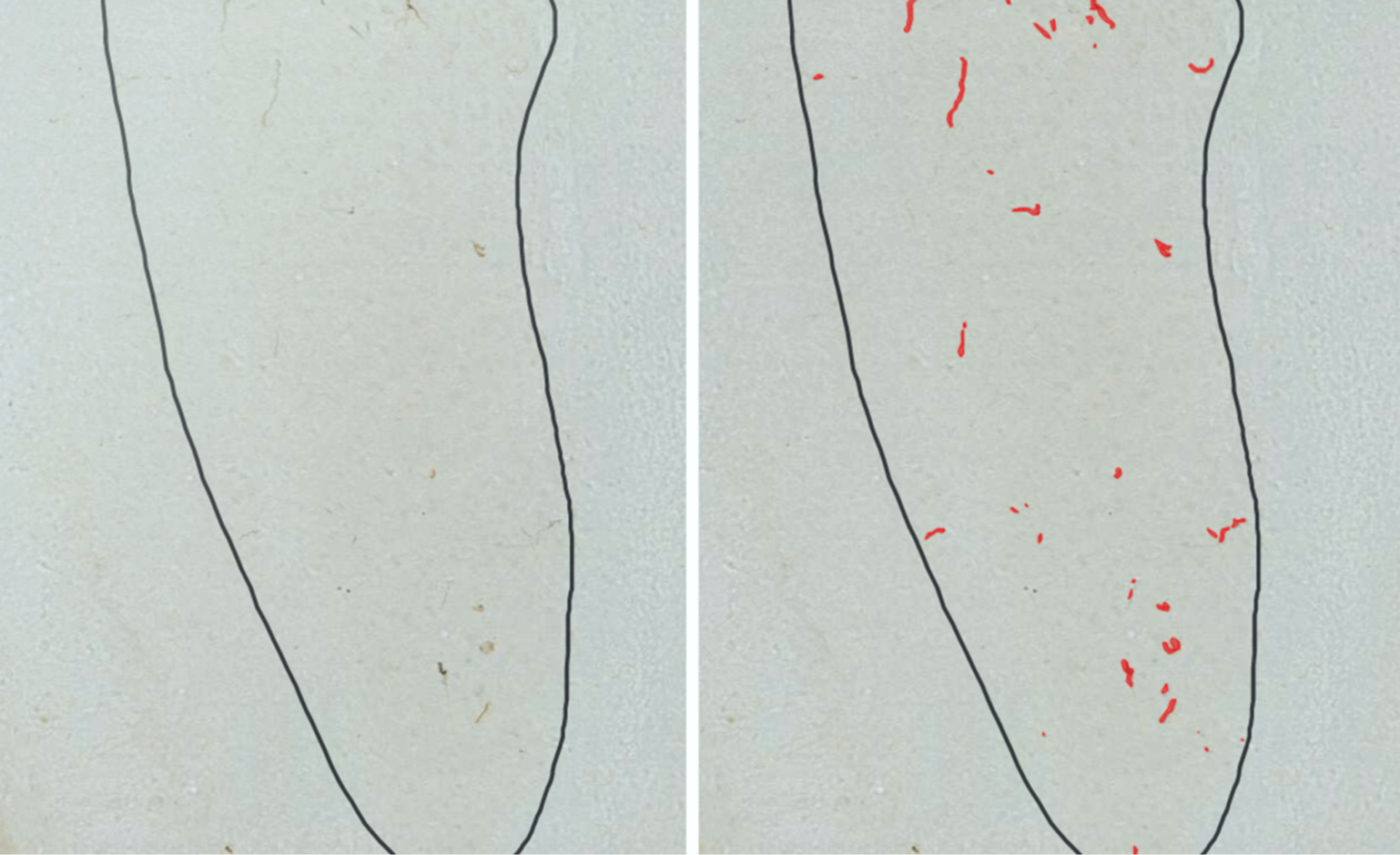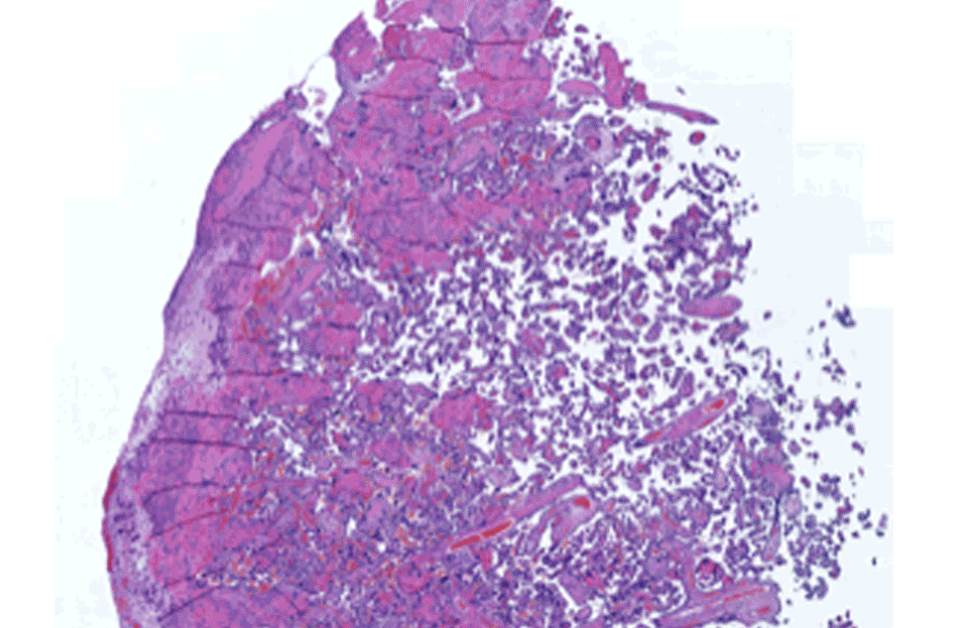Benefits
Ease of use
Using Aiforia® Create requires no data science or software programming expertise. Its cloud-based nature makes it scalable and extremely fast to implement; no installation is needed.
Broad compatibility
Aiforia® Create is compatible with any 2D image and a broad range of image file formats, including brightfield and fluorescence. It can be integrated with any existing laboratory infrastructure to enjoy the full benefits of a digitized workflow.
Versatility
Thousands of AI models have been developed with Aiforia® Create for research and clinical use cases; applications ranging from cancer research to neuroscience and even outside the medical field.
Increased speed and accuracy
Aiforia® Create supports the user by automating manual steps in AI development with features such as the patented Annotation Assistant.
AI model development made easy
Aiforia® Create allows users to develop and validate deep learning AI models for histological features and patterns in image analysis. Users can train their AI models to identify, quantify, or measure features in any 2D image.
How to get started?
-
To access Aiforia® Create, you need a subscription to our cloud-based image management and sharing platform.
-
You can then get started with the software to train and deploy your AI model. You pay only for what you use, and our science team supports you throughout your AI model development and deployment.
-
We offer scalable solutions for organizations of all sizes and projects of varying complexities.
Aiforia® Create is intended for Research Use Only (RUO).
Unique functionalities

ANNOTATION ASSISTANT
Annotate more images in less time
The patented Annotation Assistant utilizes active learning, a highly sought-after technique in artificial intelligence. It offers premade annotations on the most useful areas of training data, allowing the user to accept, modify, or reject the suggestions.

OBJECT DETECTION
Identify and count any feature
Aiforia’s object detection technology can detect thousands of different objects in complex images. It enables multi-class identification and the detection of rare objects and can be combined with segmentation and spatial metrics for enhanced analysis.

SEMANTIC AND INSTANCE SEGMENTATION
Quantify areas and dimensions with precision
Segmentation features enable precise quantification of areas and shapes, even individually when areas merge or overlap. Analysis can be further boosted when combined with object detection and spatial metrics.

TRANSFER LEARNING
Adjust your AI model with speed and ease
Transfer learning reduces the number of annotations and training cycles needed in AI development by allowing the use of existing models as a basis for AI model development and fine-tuning.

VALIDATION
Collaborate remotely through the cloud
Validation features provide an easy interface for defining validation sets and collecting validation annotations remotely. They also provide a convenient way to invite colleagues or consultants to give blinded scoring or diagnosis according to intended use criteria.
Unique functionalities
Annotation assistant

ANNOTATION ASSISTANT
Annotate more images in less time
The patented Annotation Assistant utilizes active learning, a highly sought-after technique in artificial intelligence. It offers premade annotations on the most useful areas of training data, allowing the user to accept, modify, or reject the suggestions.
Object detection

OBJECT DETECTION
Identify and count any feature
Aiforia’s object detection technology can detect thousands of different objects in complex images. It enables multi-class identification and the detection of rare objects and can be combined with segmentation and spatial metrics for enhanced analysis.
Semantic and instance segmentation

SEMANTIC AND INSTANCE SEGMENTATION
Quantify areas and dimensions with precision
Segmentation features enable precise quantification of areas and shapes, even individually when areas merge or overlap. Analysis can be further boosted when combined with object detection and spatial metrics.
Transfer learning

TRANSFER LEARNING
Adjust your AI model with speed and ease
Transfer learning reduces the number of annotations and training cycles needed in AI development by allowing the use of existing models as a basis for AI model development and fine-tuning.
Validation

VALIDATION
Collaborate remotely through the cloud
Validation features provide an easy interface for defining validation sets and collecting validation annotations remotely. They also provide a convenient way to invite colleagues or consultants to give blinded scoring or diagnosis according to intended use criteria.
Multichannel images and analysis

MULTICHANNEL IMAGES AND ANALYSIS
Apply AI to multichannel immunofluorescence images
All AI development features are applicable to multichannel images. This enables the viewing and analysis of complex immunofluorescence images.
"The Aiforia software was very easy to use by pathologists with only limited experience in deep learning. The web-based nature of Aiforia also facilitated collaborations among an international group of pathologists."
Dr. Rish K. Pai, MD, PhD, Pathologist, Mayo Clinic
"If we had not had access to Aiforia, this analysis would have been much more time-consuming. It would be a lot harder; you could even say it would have been impossible to count these individual cells."
Miika Vuorimaa, Research Scientist at Orion Pharma
“Aiforia Create is a great solution for pathologists with no data science or specific coding expertise and willing to start working hands-on with AI in their research. The cloud-based platform is very user-friendly and the open and on-demand communication with their knowledgeable team of scientists is a perk.”
Eleonora Duregon, Assistant Professor of Pathology at the University of Turin
Case study: AI-based image analysis enables prognostication in ovarian cancer
A research team from the University of Helsinki used Aiforia® Create to develop a deep learning AI model to predict patient outcomes in a complex ovarian cancer.

Case study: AI-assisted prostate cancer diagnosis
AI-assisted diagnosis was compared to visual diagnosis in a study involving H&E slides from 111 prostate cancer patients. Read about the results.

Case study: developing an AI model to determine invasion in pulmonary adenocarcinoma
Dr. Jennifer M. Boland et al. from the Mayo Clinic successfully developed an AI model to determine the invasion in pulmonary adenocarcinoma.

Case study: creating a prognostic AI model for colorectal cancer
Dr. Rish Pai from the Mayo Clinic developed an AI model to assist oncologists in deciding which CRC patients should receive chemotherapy and for how long.
/Cancer%20JPEG/colorectal-cancer_after.jpg)
Finn Pathologists case study: Ki-67 scoring of canine mast cell tumors
Veterinary pathologists from the UK-based Finn Pathologists used Aiforia® Create in the Ki-67 scoring of canine mast cell tumors.

Case study: enhancing mesothelioma research with AI
A research team from the University of Turin used Aiforia® Create to build an AI model for mesothelioma subtyping with reticulin stain. Read more or watch the video interview.

Cerba Research case study: utilizing AI in Ki-67 quantification in solid tumors
In this study, the results of Ki-67 scoring performed with Aiforia® Platform were compared against three independent pathologists on various solid tumors.

MIT case study: advancing lung cancer research with AI
Reseachers at the Tyler Jacks Lab, MIT, created artificial intelligence models to automate tumor grading as part of their lung cancer research studies.
/Cancer%20JPEG/Tumor_grading_MIT_after.jpg)
Cerba Research case study: utility of AI in Ki-67 scoring of breast cancer
A research team from Cerba Research compared the results of Ki-67 scoring performed with the Aiforia® Platform against two independent pathologists.

Case study: Ki-67 proliferation index calculation by AI
Pathologists can automate and improve the accuracy of calculating Ki-67 in any image. This case study describes the benefits of using the Aiforia software.

Case study: automating the quantification of PD-L1 in lung cancer
Liesbeth Hondelink, MSc student at Leiden University Medical Centre, describes using AI to automate the quantification of PD-L1 in lung cancer studies.
/Cancer/PD-L1%20before.png)
Sanofi case study: Parkinson's disease research with AI
The preclinical research team studying Parkinson's disease at Sanofi created their own AI model with Aiforia® Create to automate Th+ neuron quantification.

Case study: benefits of AI in Huntington's disease image analysis
PhD student Polina Stepanova discusses the benefits of using AI for mutant huntingtin detection to improve prediction methods and develop new therapies.

Massachusetts General Hospital case study: AI-assisted image analysis of neurodegenerative disease markers
Researchers from Massachusetts General Hospital used Aiforia’s AI for the analysis of histopathological markers in neurodegenerative diseases.

Case study: AI-assisted neuron quantification for Parkinson's disease
Researchers at the University of Helsinki deployed artificial intelligence models to automate Parkinson’s disease neuron counting.

Case study: advancing neurodegenerative disease research with AI
A neuroanatomy lab in Pamplona, Spain, uses Aiforia® Create to advance neurodegenerative disease research.

Case study: the use of AI in Parkinson’s disease research
Interview with Duke University PhD Student on dopaminergic neuron quantification in Parkinson’s disease research.

Van Andel Institute case study: quantitative assessment of alpha-synuclein immunoreactivity with AI
Van Andel Institute created four AI models with Aiforia to provide unbiased, quantitative analysis for Parkinson’s disease research.

Case study: benefits of AI in Parkinson’s disease image analysis
Parkinson’s disease, a neurodegenerative disorder, is commonly detected using brain scans and analyzed manually. We interviewed neuroscience researcher Joan on the benefits of AI in PD research.

Barrow Neurological Institute case study: stereology versus AI in neuron quantification
Stereology has long been a reliable method for neuron quantification, but how does it compare in speed and accuracy to artificial intelligence based tools?

Case study: AI model can improve large droplet fat quantitation in liver pathology
Dr. Maxwell L. Smith from Mayo Clinic built an AI model to accurately estimate large droplet fat in liver sections prior to transplantation.

NAFLD case study: assessing liver histology with AI
This case study describes the use of AI in studying nonalcoholic fatty liver disease (NAFLD) and its capability to segment structures in liver histology.

Case study: evaluating prognostic indicators in primary sclerosing cholangitis with AI
A pathologist studying primary sclerosing cholangitis (PSC) created a deep learning AI model to evaluate novel prognostic biomarkers of the liver disease.

Case study: creating a prognostic AI model for colorectal cancer
Dr. Rish Pai from the Mayo Clinic developed an AI model to assist oncologists in deciding which CRC patients should receive chemotherapy and for how long.
/Cancer%20JPEG/colorectal-cancer_after.jpg)
Case study: differentiating interstitial lung disease subtypes using AI-based image analysis
Dr. Maxwell L. Smith from Mayo Clinic developed two AI models to detect and quantify histopathologic features in interstitial lung disease (ILD) with the goal of using AI to help differentiate ILD subtypes.

Case study: developing an AI model to determine invasion in pulmonary adenocarcinoma
Dr. Jennifer M. Boland et al. from the Mayo Clinic successfully developed an AI model to determine the invasion in pulmonary adenocarcinoma.

Case study: enhancing mesothelioma research with AI
A research team from the University of Turin used Aiforia® Create to build an AI model for mesothelioma subtyping with reticulin stain. Read more or watch the video interview.

MIT case study: advancing lung cancer research with AI
Reseachers at the Tyler Jacks Lab, MIT, created artificial intelligence models to automate tumor grading as part of their lung cancer research studies.
/Cancer%20JPEG/Tumor_grading_MIT_after.jpg)
Case study: quantitating histopathological features of idiopathic pulmonary fibrosis
Kati Mäkelä, an MD specializing in pulmonary medicine, tells us about using AI to quantitate histopathological features of idiopathic pulmonary fibrosis.
/Other%20medical%20areas%20JPEG/lung_fibroblast_lymphocytes_after.jpg)
Galileo case study: exploring AI’s potential in kidney transplantation
An Italian research team built an AI model for kidney pathology to assist on-call pathologists and renal pathologists in their routine work.
/Other%20medical%20areas%20JPEG/kidney_cortex_medulla_after.jpg)
Case study: AI-based image analysis enables prognostication in ovarian cancer
A research team from the University of Helsinki used Aiforia® Create to develop a deep learning AI model to predict patient outcomes in a complex ovarian cancer.

Case study: evaluating stages of the estrus cycle with AI
Pathologist Dr. Leena Strauss developed an artificial intelligence model to evaluate the stages of the estrus cycle in cytology samples.
/Other%20medical%20areas/Reproductive%20disease.png)
CRL case study: AI-assisted screening of bone marrow cellularity changes
Veterinary pathologist, Mark Smith, from Charles River Laboratories describes using AI models to screen for bone marrow cellularity changes.

Faron Pharmaceuticals case study: using AI to perform spatial analysis in cancer drug development
Elisa Vuorinen at Faron Pharmaceuticals built an AI model to quantify and localize Clever-1 in the tumor microenvironment using Aiforia® Create.

Orion Pharma case study: accelerating preclinical neurotoxicity analysis with AI
Scientists at the pharmaceutical company Orion Pharma developed artificial intelligence models to automate preclinical neurotoxicity assessment.

CRL case study: AI-assisted screening of bone marrow cellularity changes
Veterinary pathologist, Mark Smith, from Charles River Laboratories describes using AI models to screen for bone marrow cellularity changes.

CRL case study: accelerating preclinical analysis with AI
Pathologists at Charles River Laboratories used Aiforia's AI development tool globally to automate preclinical assessments.

Experimentica case study: accelerating preclinical analysis of ocular diseases
Scientists at the CRO Experimentica describe using AI to analyze Spectral Domain Optical Coherence Tomography scans to identify neovascular lesions.

Case study: infectious diseases and AI
View case studies of using deep learning AI in studying and diagnosing infectious diseases, such as malaria, tuberculosis, and hantavirus.

Case study: automating the detection of malaria parasites in blood smear
AI-assisted analysis of malaria parasites has the potential to significantly improve diagnosis and treatment of the deadly disease. Learn more.
/Other%20medical%20areas/Malaria%20after.png)
Case study: using AI to identify and research orthohantavirus infections
Interview with virologist Tomas Strandin on the use of AI in the quantification of antibodies signaling orthohantavirus infections

Request a demo
Discover the power of AI for image analysis
Learn how to enhance your image analysis work in diagnostic pathology, preclinical studies, and medical research. The demo will be tailored to your interests.
The demo will help you understand:
- How AI-assisted image analysis can increase efficiency, precision, and consistency.
- The versatile capabilities Aiforia® Create offers for creating, customizing, and validating deep learning AI models for histological features and patterns in image analysis.
We can demonstrate the tool on your own images or any of our application examples (i.e., neuron quantification, automated tumor grading, NASH analysis, etc.).
Fill in the form, and one of our experts will contact you shortly to schedule the time.
/Cancer/PD-L1%20after.png)
/Neuro%20JPEG/iron_detection_after.jpg)
/Neuro%20JPEG/astrocytes_orion_before.jpg)
/Liver%20JPEG/PSC_before.jpg)
/Other%20medical%20areas/DSS-colitis-2-after-1.png)
/Other%20medical%20areas%20JPEG/tuberculosis_after.jpg)
/Other%20medical%20areas/Reproductive%20endometrial%20after.png)

/Other%20medical%20areas%20JPEG/malaria_RBC_after.jpg)

/Other%20medical%20areas/Coronavirus%20after.png)
/Other%20medical%20areas/Tuberculosis%20after.png)

/Other%20industries/Salmon%20skin%20after-1.png)